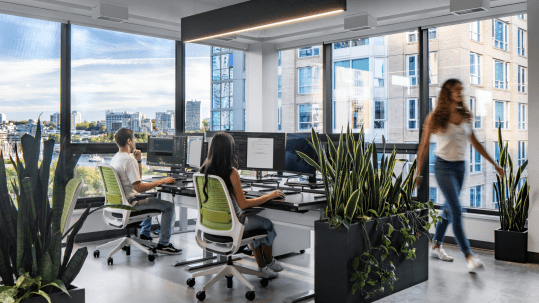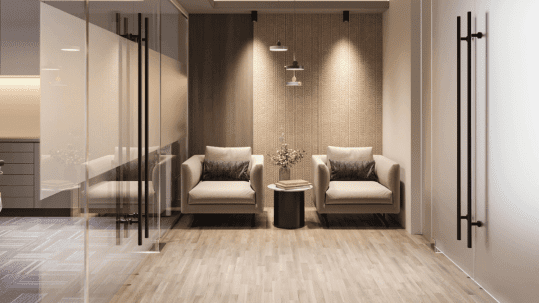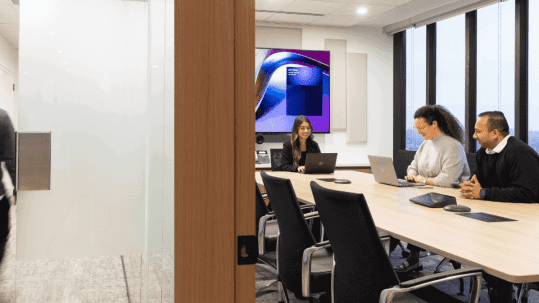Innovative and leading organizations the world-over are busy trying to support employees who are adapting to the open office concept in an effort to retain top talent, encourage collaboration, and boost creativity and efficiency.
The concept of open offices is geared towards increasing employee satisfaction and job fulfilment, but the open office is also sometimes criticized for an increase of distractions, eliminating much-needed privacy, and reducing overall employee motivation. Helping staff pivot around a newly integrated open office concept lies in the ability to find common ground with employees, identify with spatial shortcomings, and improve the work environment.
The issue with open concept offices is: research shows that many employees don’t like them. This means adopting adaptive strategies to optimize and tailor the work experience through an open concept office will be key to transitioning to the new space and boosting the employee experience.
Benefits
Increased Communication
One of the benefits employers are eager to cash in on, is an increase of quick communication that speeds up the workflow of the entire office. This boost in efficiency and openness reduces the time it takes to find the info employees need to do their jobs, makes collaboration instant, and is supposed to maximize the chance for encounters that foster discussions relevant to the company cause.
But – and this is a big but – increased communication must start with a different type of communication before all of these glorious benefits can come your way. Adapt to an open concept office space by getting everyone together and communicating the perceived hurdles and pain points employees may have with the new open space, and discuss ways that can help the entire team feel heard and respected.
For example, lay out some ground rules for how to work as a team with differing working styles in an open space by coming up with an open block of communication time, rather than a free-for-all during the whole day. Alternatively, come up with a universal office-wide symbol for privacy, like a flag or another visual cue that the individual needs privacy at this time.
Ground rules for distracting and unwelcome behaviour is important so employees know ahead of time the way that benefits the majority of their peers – things like loud, off-topic discussions, music, constant personal phone notifications, etc, are all issues that can be addressed to test out a proposed ban and/or set of rules.
This type of increased communication in the form of a formal discussion of boundaries and working styles is first in your journey to adapt to an open office concept and harness the benefits of a boost to communication.
Supportive of Shared Goals
Open office plans are critical for teams who need to find ways to respond to change and support shared goals through collaboration. From an employee perspective, the open office concept is a wonderful weapon that helps combat the time-tested obstacles of cubicle and/or private office based spaces. Open space offices support shared goals because they unify employees in one room, under one roof – so to speak – working towards a collective goal.
To adapt to the new open concept space, employers may be wise to evaluate and formulate new teams of individuals who’s working styles are complementary, creating an optimized environment for support, efficiency, and goal-based work.
Instant Help
Open office concepts help teams that need to quickly and efficiently exchange information throughout the day in short interactions. The open concept corrals employees working together in one common space and places collaborative information right in the neighbours seat beside them. This means an accelerated working environment that minimizes wait times for data and shared information, and a boost to the availability of help, and new ideas.
When help is instantaneous, employees feel empowered and confident in their approach to new and complex goals, and can also benefit from observing and utilizing the skill sets of their colleagues in such close quarters.
Discuss the Vision Beforehand
One of the major problems with the changeover to an open concept office space is, there’s some considerable research that demonstrates employees don’t want to embrace the change. In fact, over 70% of offices in the US today are open concept, according to the International Facility Management Association, so there’s evidence to support that employers just don’t care about how employees react and perform under these new parameters. Why? Open offices are cheaper to create and maintain, and with time, can create great office culture and performance.
So, the answer to bridging the gap between reluctant employees and employers eager to make the change, is a formal, excited discussion about the whole idea before it takes place. Get the entire team together to talk about the benefits you’re planning to implement- maybe a cafe style collaborative working space, or an open desk corral that is specifically designed to use the latest technology, etc.
These perceived perks are great ways to discuss the vision for your new open concept office plan before knocking down walls – and represent a good way to head off any negativity or reluctance from staff.
Enthusiasm is King
Many companies and organizations do well by embracing a positive attitude from their internal leaders to communicate ideas about a new office space to their employees. Being enthusiastic brings new meaning to the change, and can help employees feel satisfied and optimistic about the information that’s relayed to them.
The Harvard Business Review found in a study investigating the transition to an open concept office, that when business leaders were positive about the change, company identity flourished and were more likely to embrace the new office space. In the study, many employees were initially worried their main modes of working would be threatened – independent working with minimal supervision and disruptions – but when their internal leaders expressed positive messages and welcomed the move, most workers felt reassured about the change.
Empower Your Staff to Make the Space Their Own
Changing working environments is hugely dependent on how workers relate to their surroundings; changing the dynamics of a working environment can be really negative when workers identities are removed from the space altogether. The HBR also found in their study that when employees were encouraged to make the new space their own, identity was left intact and remained positive.
These improvised and collaborative space designs ended up being more colourful and included personal touches – some teams even felt compelled to arrange desks to help meet their needs as the space around them changed, fostering a renewed sense of control, and freedom.
When trying to adapt to a new open concept office space, encourage your staff to make the space their own by trying a few different things: layouts, desk configuration, furniture placement, colour, the inclusion of plants, etc. When you give creative control to your employees, the transition from traditional office space to new open concept office space will be much easier, and more welcome.
—–
Adapting to the open office concept also means understanding that it doesn’t work for everyone. Playing to the strengths and hurdles you know exist within your staff is key to finding ways to adapt to the open office concept. When in doubt, you can work with a commercial interior designer on your workplace strategy and build a framework for an improved open office concept.






